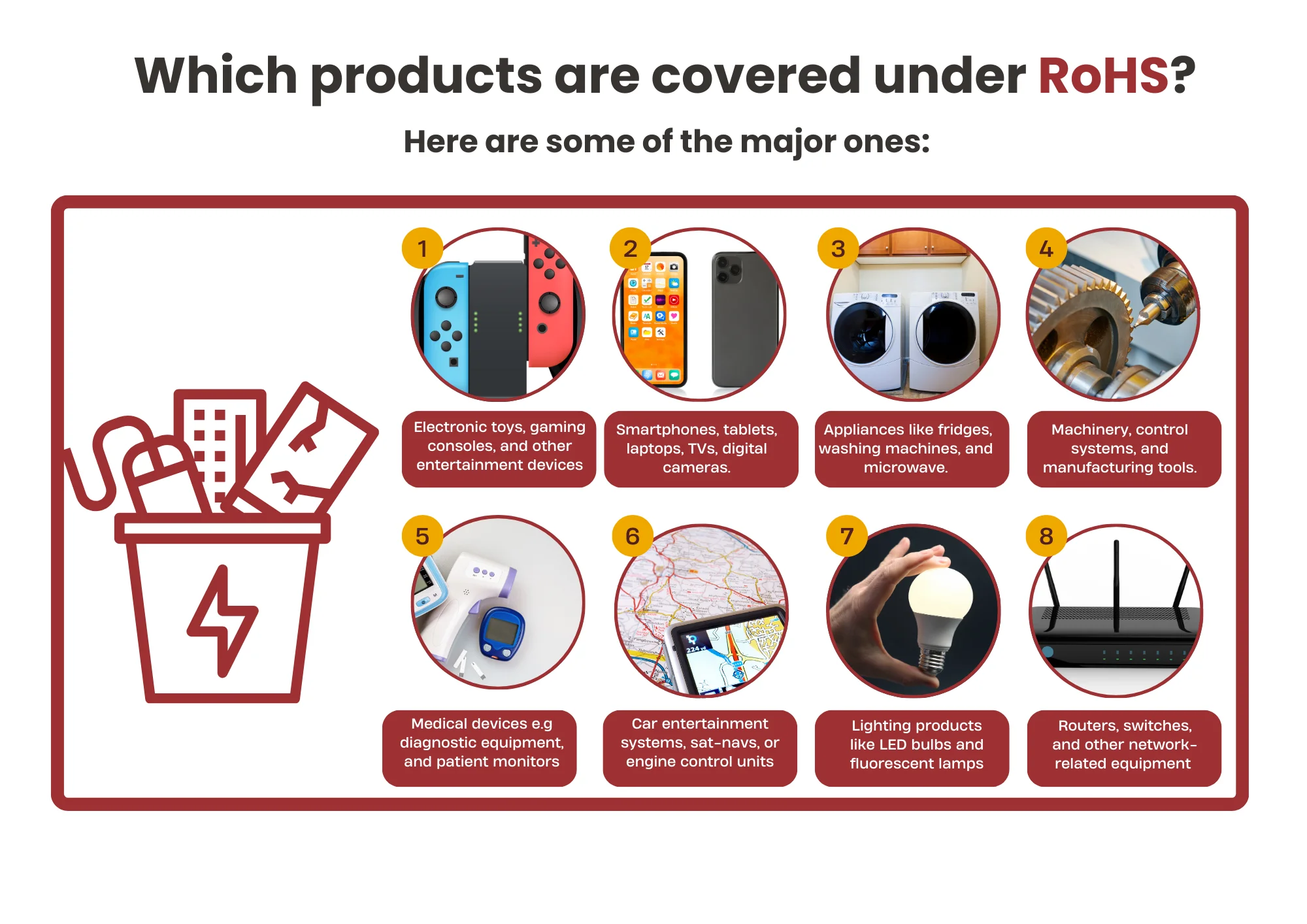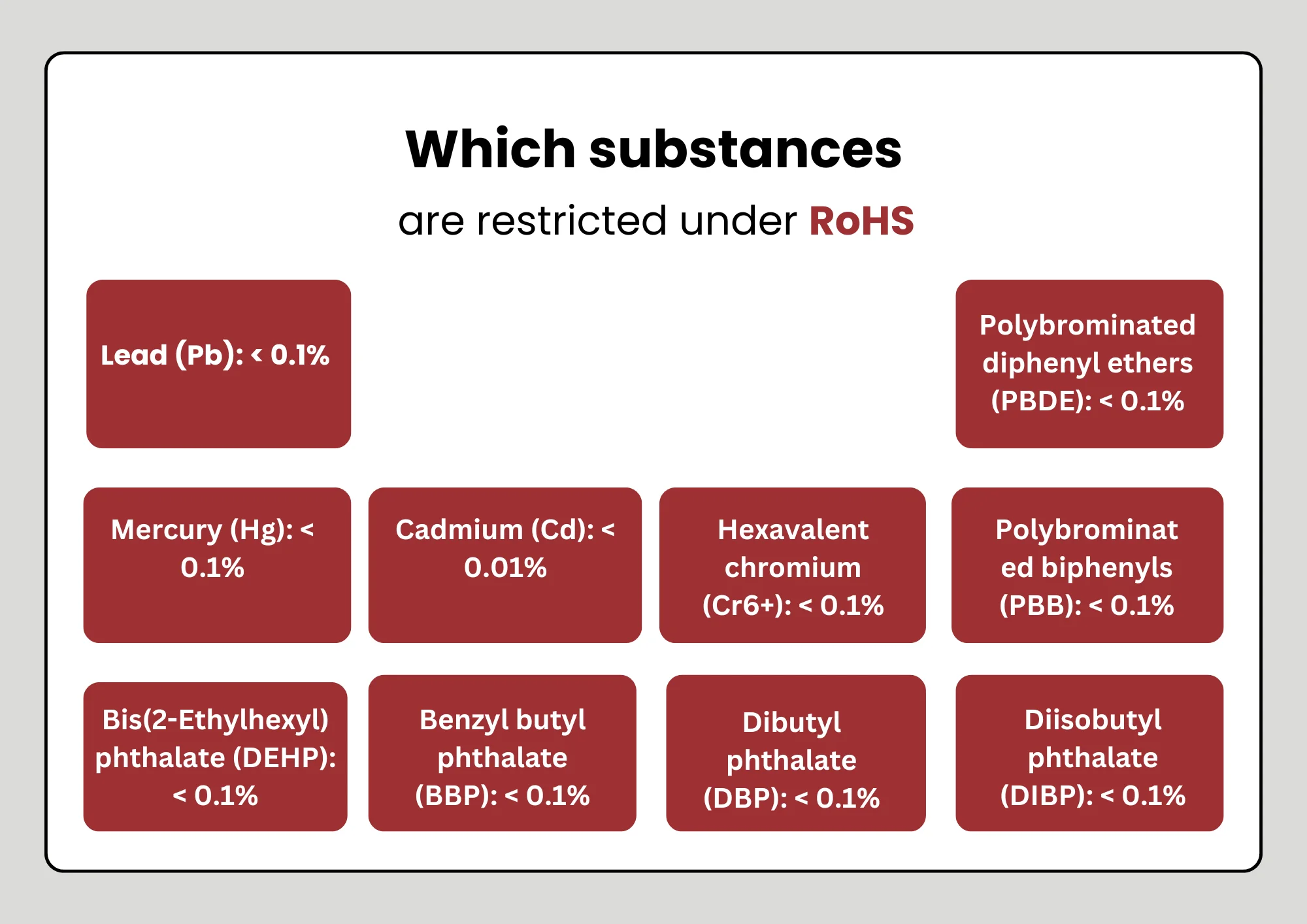
What is RoHS Compliance Certification?
What is ROHS Testing?
RoHS stands for "Restriction of Hazardous Substances." It is a regULation established by the European Union (EU) to limit the use of certain hazardous cheMICals in electrical and electronic equipment (EEE) to protect the environment and human health.

Companies producing these products must undergo rohs testing to ensure no restricted toxic substances are used in their products. Currently, RoHS regulations prohibit 10 substances, and manufacturers must comply to sell their products in the EU market.
The 10 Restricted Substances and Their Maximum Concentrations:
1. Lead (Pb): < 0.1%
2. Mercury (Hg): < 0.1%
3. Cadmium (Cd): < 0.01%
4. Hexavalent Chromium (Cr6+): < 0.1%
5. Polybrominated Biphenyls (PBB): < 0.1%
6. Polybrominated Diphenyl Ethers (PBDE): < 0.1%
7. Di(2-ethylhexyl) Phthalate (DEHP): < 0.1%
8. Benzyl Butyl Phthalate (BBP): < 0.1%
9. Dibutyl Phthalate (DBP): < 0.1%
10. Diisobutyl Phthalate (DIBP): < 0.1%

How Is RoHS Testing Conducted?
RoHS Compliance is assessed by detecting hazardous chemical substances through testing. Two common methods include:
1. XRF Spectrometry (X-Ray Fluorescence):
- How it works: High-energy X-rays are directed at a sample, exciting the material to emit secondary fluorescence X-rays. The emitted rays are analyzed to identify the elements and their concentrations.
- Advantages:
- Rapid detection of heavy metals like lead.
- Suitable for homogeneous materials (e.g., solid plastics or metals).
- Low cost, making it a popular choice for manufacturers.
2. Chromatography:
- How it works: Chemical methods are used to separate mixtures, enabling the analysis of specific components and their concentrations.
- Applications:
- Used to detect PBB, PBDE, and phthalates.
- Particularly effective for non-homogeneous materials or trace levels of specific chemicals.
How to Obtain RoHS CoC or DoC?
- Certificate of Conformity (CoC):
Certifies that your product has been tested in a laboratory and complies with RoHS standards.
- Declaration of Conformity (DoC):
A self-declaration by suppliers, based on test results, stating that their products meet RoHS requirements.
To obtain a CoC, suppliers must commission reliable laboratories to test their products. CoC is issued by the laboratory, while DoC is a formal commitment from the supplier.
How to Ensure Your Product Complies with RoHS?
To ensure RoHS compliance, proper testing and documentation are requiRED.
China JJR Laboratory offers professional support to help ensure your electrical and electronic equipment (EEE) complies with RoHS regulations:
- Laboratory Accreditation: Accredited by CNAS (China National Accreditation Service).
- Services Provided: Tests to detect restricted substances and provides clear results.
- Advantages: Simplifies the RoHS testing process, ensuring smooth market entry.
China JJR Laboratory RoHS Testing Solutions
China JJR Laboratory provides professional and reliable RoHS testing services to help companies meet EU regulatory requirements:
- Service Scope: Household appliances, IT equipment, consumer electronics, lighting equipment, power tools, toys, and more.
- Service Details:
- On-Site Testing: Quick testing using CNAS-accredited in-house labs.
- Documentation Review: Provides detailed compliance reports and support.
- Process Audit: Optimizes compliance processes and reduces the risk of violations.
Choose China JJR Laboratory to ensure your products comply with RoHS standards and achieve successful market entry!
Email:hello@jjrlab.com
Write your message here and send it to us
 WEEE Registration for Waste Electrical &Electr
WEEE Registration for Waste Electrical &Electr
 MSDS Chemical Safety Testing
MSDS Chemical Safety Testing
 What Are the Differences Between UK REACH and EU R
What Are the Differences Between UK REACH and EU R
 E-Cigarette GB 41700 Compliance Testing
E-Cigarette GB 41700 Compliance Testing
 What Are the Testing Items of California Propositi
What Are the Testing Items of California Propositi
 E-Cigarette EU TPD Testing
E-Cigarette EU TPD Testing
 Testing Certification for E-cigarettes Exported to
Testing Certification for E-cigarettes Exported to
 What is Amazon US CPC Certification?
What is Amazon US CPC Certification?
Leave us a message
24-hour online customer service at any time to respond, so that you worry!




